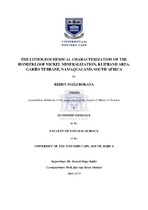| dc.description.abstract | A magmatic Ni-Cu (±Co-Zn) sulphide deposit, named the Hondekloof prospect, is present in the Kliprand area at the border between the Northern Cape and Western Cape Provinces of South Africa. The deposit occurs in the central part of the polyphase deformed and highly metamorphosed Garies Terrane, in the Namaqua Sector, along the south-western margin of the Mesoproterozoic Namaqua-Natal Metamorphic Province. Given the sub-economic concentrations yielded from evaluation of three of its known massive-sulphide lenses evaluated, the Hondekloof prospect has received relatively little consideration in terms of ongoing scientific research. Consequently, many aspects related to the genesis, classification and tectonic evolution of the deposit, to date, remain relatively unclear and unknown. The present contribution has therefore been geared to addressing some of those issues in view of the new data obtained on the country rocks and host rocks to the mineralization.Six exploration boreholes were logged, sampled and examined at the deposit site in Kliprand. A total of seven host rocks, namely meta-gabbronorite, biotite gneiss, feldspathic-biotite-garnet gneiss, pink gneiss, meta-syenite as well as enderbite along with a garnetiferous quartzofeldspathic rock occur in association with the sulphide mineralization. The origin, protoliths and tectonic settings of the host lithological units were determined and discussed in terms of modern plate tectonic principles. The meta-gabbronorite (the actual ore host), which had a magmatic protolith and forms part of the pre- to syn-tectonic Oorkraal Suite, displays the chemical characteristics of a depleted mantle origin (source of MORB-like melt), generated within a continental tectonic rift environment. Country rocks with sedimentary protoliths have chemical characteristics indicating a psammitic, felsic to intermediate provenance deposited within a regional subduction-related tectonic setting. A number of geochemical indices, of which the combination of element-ratios (such as Fe2O3/Al2O3 vs. TiO2/Al2O3, as well as Cr vs. Ni, amongst others) created as exploration vectors towards mineralisation, have shown potential for pointing towards the direction of the mineralization. Based on classification schemes of magmatic Ni sulphide deposits, it is has been suggested that the Hondekloof prospect could be classified as a low MgO, conduit-type, disseminated magmatic nickel sulphide deposit. | en_US |

